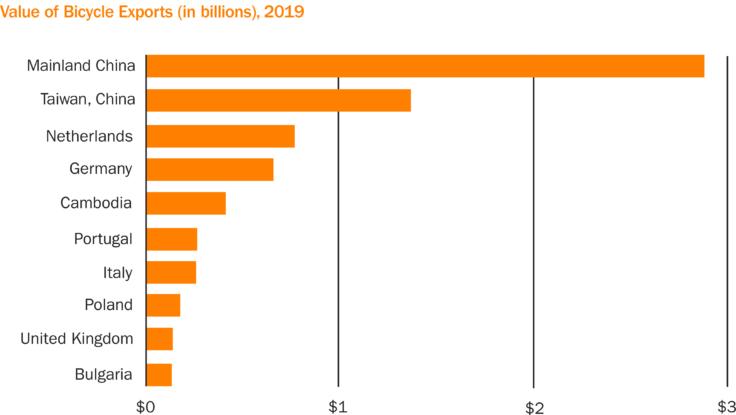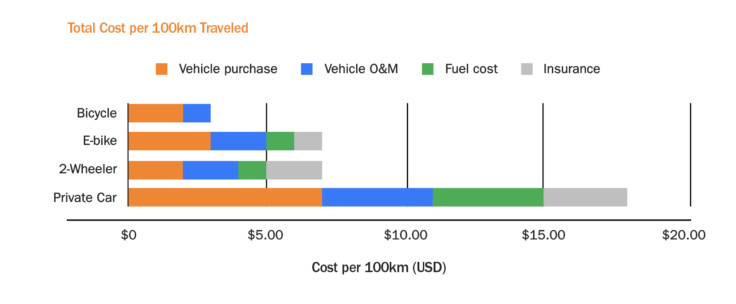
June 14, 2022
How Cycling Powers People and Economies
During the COVID-19 pandemic, when so much of the world came to a standstill, bicycles kept moving.
Cycling went beyond connecting people to essential services like healthcare, grocery stores, and front-line jobs — it also served as a critical means for reaching friends and loved ones. In fact, in 2020, there was so much demand for cycling that many manufacturers could not keep up. The global market for bicycles was estimated at about USD $54 billion, and is expected to reach USD $78 billion by 2026. Now, as fuel prices continue to soar and economic uncertainty grows, people are again turning to bicycles for an affordable, accessible, and clean mode of transportation. Nevertheless, despite this mass shift towards cycling seen around the world, many cities still lack the necessary infrastructure to make it truly safe, efficient, and sustainable for all.

Many cities have witnessed firsthand the benefits of investing in infrastructure and other street design improvements that support safer, more direct, and more connected cycling trips. Unfortunately, there are still many cities that may not be convinced that such investments are “worth” the upfront costs. We know that cycling offers one of the most low-cost, high-yield, and scalable solutions to many of our most pressing climate and equity issues. There needs to be a greater emphasis placed on developing high-quality infrastructure that encourages people to choose cycling as a primary mode of transport.
Research also shows that cycling is the most affordable mode per kilometer traveled for individuals. As a transport mode, it reduces costs for cities and society by lowering greenhouse gas emissions, reducing air pollution, improving road safety, and creating a healthier population. Cycling infrastructure and cycle-friendly streets have also been found to increase property values and facilitate higher retail sales, which in turn generates more municipal revenue for local governments.

To make the economic case for cycling and demonstrate how investments in related infrastructure can unlock economic benefits, ITDP released the Making the Economic Case for Cycling report. This report explores how achieving cost-saving outcomes and economic opportunities requires upfront investment in well-designed cycle infrastructure, including protected cycle lanes, bicycle parking, and bikeshare programs. Notably, the scale of investment needed to achieve systemic change and have a real impact on climate change is small — compared to other transport modes — and presents one of the highest returns on investment.
The report emphasizes that demand for, and access to, bicycles can spur new economic opportunities in related sectors, including bicycle manufacturing, tourism, shared micro-mobility, local goods delivery, and even informal street vending. In Europe, the cross-country Eurovelo cycle route network lays the foundation for a cycle tourism sector that generates an estimated €44 billion per year, 16% more than even the European cruise ship sector. There is also significant potential for jobs creation related to these industries, as well as for supporting more cycle infrastructure projects. In fact, in the United States, every USD $1 million spent on cycle infrastructure creates up to 34 state and local jobs, compared to just 8 state jobs created by spending the exact same amount on roads.

Investing in cycling infrastructure is an investment in the resiliency of all of our transportation systems. Increasingly frequent health, climate, and natural disasters threaten our ability to travel by car and by public transportation, as much of the world witnessed during the COVID-19 pandemic. Following these global disruptions, bicycles serve not only as a primary mobility option but as a way to quickly deliver medicines, essential goods, and to reach communities in-need. Bicycles are an adaptable and flexible transport mode when other modes fail, keeping people and commerce moving and minimizing costs associated with an economic standstill. Cycling is both a means to avoid the worst climate impacts and a means for adapting society to these impacts. To truly unlock the economic, social, environmental, and health benefits of cycling, we must start by strategically investing in better and safer infrastructure today.
Download the full “Making the Economic Case for Cycling Report” here >>
